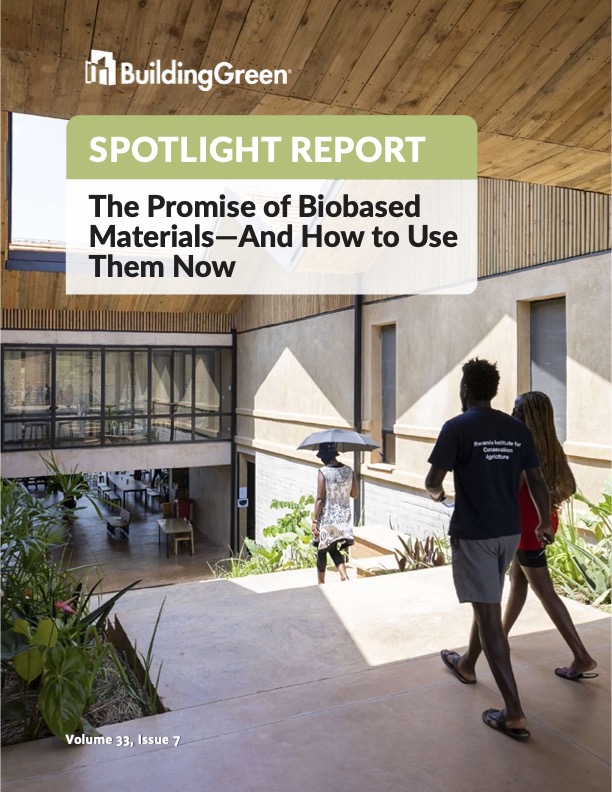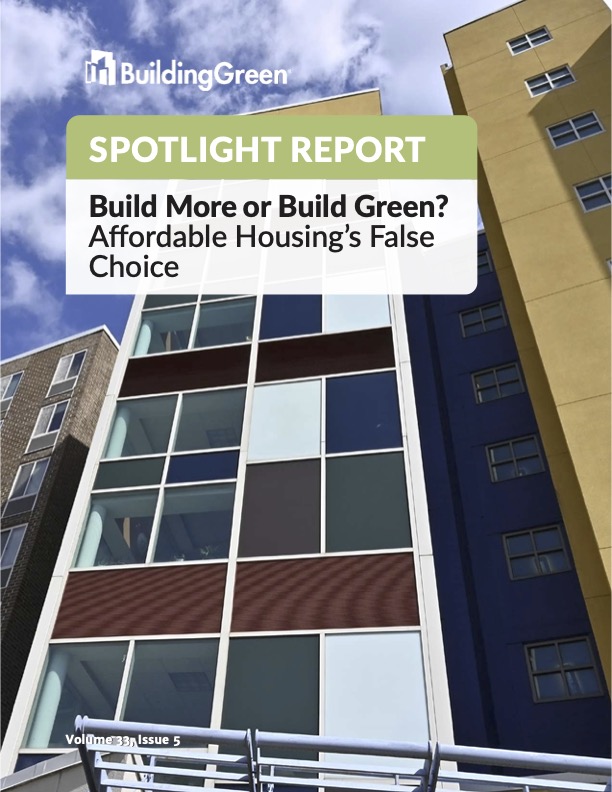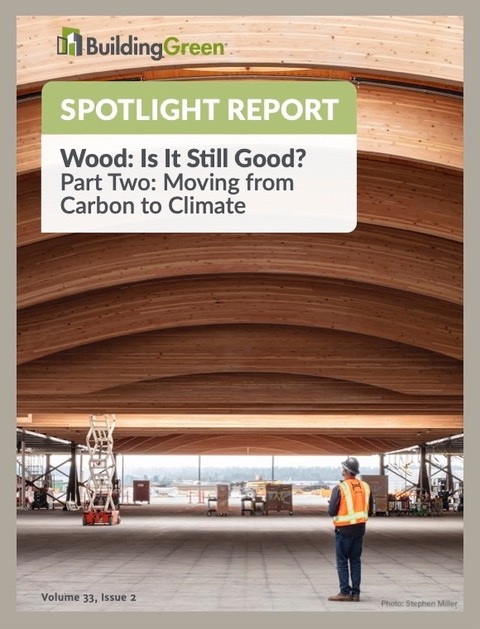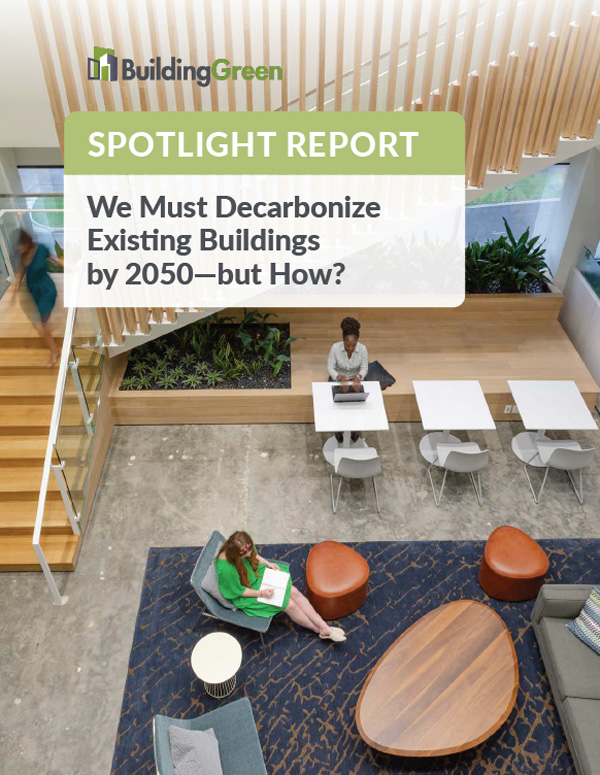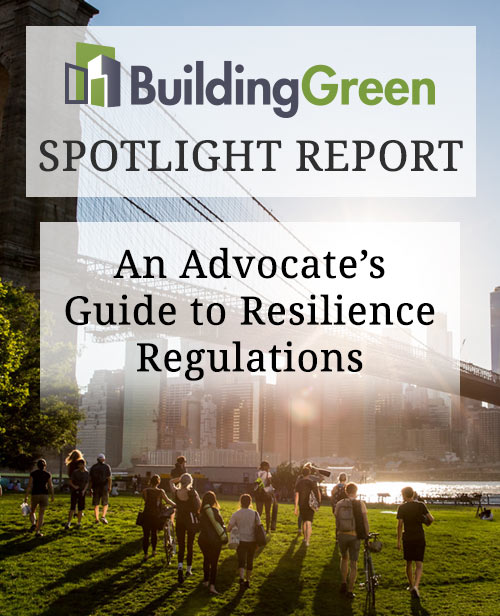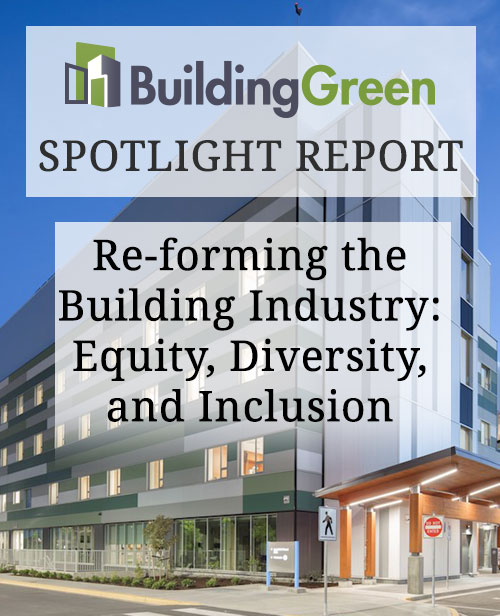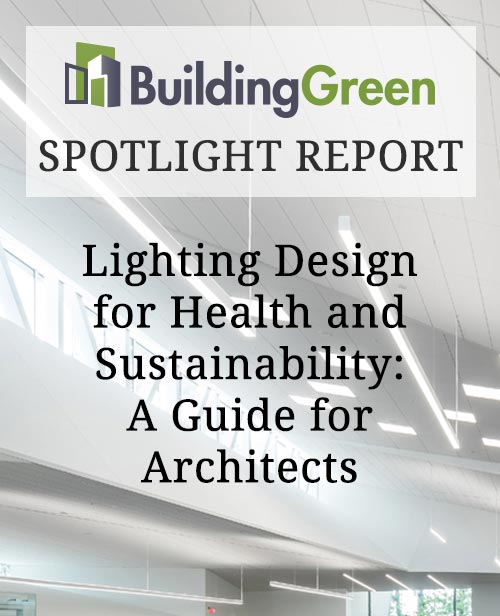For discount pricing on our digital downloads and free Spotlight Report downloads, learn more about BuildingGreen Premium subscription and LEEDuser Premium subscription.
Can’t find what you’re looking for? Please contact customer support.
Exam Preparation
WELL AP Exam Study Guide and Practice Exams
BuildingGreen offers the best available WELL Accredited Professional study guide, and the only one you'll need.
Learn more »Price: $149
Premium subscriber price: $99
LEEDuser's Guide to Passing the LEED v4 AP Exam
The only study guide you’ll need to pass the LEED AP exam on the first try.
Learn more »Price: $129
Premium subscriber price: $89
LEEDuser's Study Guide to the LEED v4 Green Associate Exam
Pass the LEED Green Associate exam on the first try—without wasting your study time.
Learn more »Price: $149
Premium subscriber price: $99
BuildingGreen Guides
The BuildingGreen Guide to ESG
How to keep up with the environmental, social, and governance programs that are changing the building industry.
Learn more »Price: $99
Premium subscriber price: $79
The BuildingGreen Guide to Building Product Certifications and Ecolabels
The BuildingGreen Guide to Building Product Certifications and Ecolabels provides guidance on product certifications and ecolabelss.
Learn more »Price: $99
Premium subscriber price: $79
The BuildingGreen Guide to Thermal Insulation
The BuildingGreen Guide to Thermal Insulation provides guidance on performance, health, and environmental considerations.
Learn more »Price: $129
Premium subscriber price: $99
Spec This, Not That: Avoiding Toxic Chemicals in Commercial Building Projects
Spec This, Not That details approaches used by architects, designers, contractors, and building owners to reduce chemical hazards in their building projects.
Learn more »Price: $129
Premium subscriber price: $89
The Cost of LEED v4
Our report is structured to enable project teams to systematically address the complexity of evaluating sustainable design strategies on a LEED for New Construction (LEED-NC) v4 project.
Learn more »Price: $99
Premium subscriber price: $67
Fundamentals of High Performance Building Assemblies
BuildingGreen's four-part course, designed for architects and builders, provides methodologies for how best to design and manage these details and achieve superior performance—while avoiding expensive pitfalls.
Learn more »Price: $199.95
Premium subscriber price: $149
BuildingGreen Spotlight Reports
The Promise of Biobased Materials—and How to Use Them Now
There is a lot of hype over carbon storage and other benefits of natural materials, but their potential is real. Here are some that are ready for prime time—and the ones we hope will take off next.
Learn more »Price: $39
Build Green on a Budget: Lessons from Affordable Housing
Sustainability doesn’t have to cost more—and no one knows that better than affordable housing experts. But every project type can benefit from these 12 cost-reducing ideas that support people and the planet.
Learn more »Price: $39
Build More or Build Green? Affordable Housing’s False Choice
The U.S. is grappling with a housing crisis, climate change, and a legacy of racism and segregation. But we can address these problems all at once by centering community.
Learn more »Price: $39
Wood: Is It Still Good? Part Two: Moving from Carbon to Climate
Many people hope mass timber will drive decarbonization—but scaling that up could make things worse. Instead of embodied carbon alone, “climate-smart” practices focus on our increasingly fragile forests.
Learn more »Price: $39
Wood: Is It Still Good? Part One: Embodied Carbon
Wood products are widely regarded as carbon neutral—or even better. With new research challenging that idea, a more cautious approach is emerging. Because the climate stakes are too high for us to get this wrong.
Learn more »Price: $39
Keeping PFAS Forever Chemicals out of Building Products
Per- and polyfluoroalkyl substances (PFAS) have been linked to negative health and environmental impacts. Getting them out of our building products is going to require work.
Learn more »Price: $39
The Missing Embodied Carbon Link: Construction
Some researchers say construction emissions could account for as much as 30% of a project’s embodied carbon. What can be done about it?
Learn more »Qualifies for 1 AIA - LU|HSW hour and 1 GBCI CE hour.
Price: $39
Using Low-Carbon Concrete in Your Next Project
Advancements in low-carbon concrete materials and strategies have led to greater adoption in much of the U.S. Now it's time to start using them.
Learn more »Qualifies for 1 AIA - LU|HSW hour and 1 GBCI CE hour.
Price: $39
Integrative Process: Pathways to Performance and Regeneration
An integrative process can streamline workflows and drive higher performance. But if you do it well, it’s so much more.
Learn more »Qualifies for 1.5 AIA - LU|HSW hour and 1.5 GBCI CE hour.
Price: $39
ESG: 6 Things Building Professionals Need to Know
Clients need AEC professionals to help them achieve environmental, social, and governance goals. Here’s how people are turning aspirations into strategies.
Learn more »Qualifies for 1.5 AIA - LU|HSW hour and 1.5 GBCI CE hour.
Price: $39
We Must Decarbonize Existing Buildings by 2050—but How?
Deep energy retrofits and existing building electrification are critical to curbing carbon emissions. Here’s how to make the case and get it done.
A carbon-neutral city by 2030: that’s the goal of Ithaca, New York’s Green New Deal, adopted in June 2019. We’re not just talking about municipal operations or new building construction, though these are part of the resolution. No, this is about city-wide carbon neutrality, including the electrical grid and privately owned transportation and existing buildings. Implementation of the resolution must correct historic economic and racial inequities.
Learn more »Qualifies for 1.5 AIA - LU|HSW hour and 1.5 GBCI CE hour.
Price: $39
Assessing Climate Hazards: The First Step in Resilient Design
The headlines are everywhere—from heat waves in Europe to wildfires in the Western U.S. to tidal flooding in Florida. In this age of climate change, just as there’s an urgent need to reduce carbon emissions and other greenhouse gasses, we also need to adapt and invest in resilience.
Learn more »Qualifies for 1.5 AIA - LU|HSW hour.
Price: $39
Constructing Change: The Contractor’s Commitment
Health and wellness are in high demand in sustainable design. Soft daylight, superb indoor air quality, enhanced thermal comfort, great ergonomics … all these design elements and more are becoming standard for students, patients, and office workers.
Once design is done, though, the human beings who construct the resulting high-performing buildings almost never get similar benefits. What about them?
And what about other jobsite issues, like carbon emissions and water use? What about ensuring that specified green building products actually make it into the project?
There is a stubborn gap between green design and green building. But a group of industry leaders is out to close it with a program called the Contractor’s Commitment to Sustainable Building Practices. In this course, you’ll learn all about the new commitment—who’s signed, why it’s important, and the impact it’s already having on the industry.
Learn more »Qualifies for 1 AIA LU|HSW and 1 GBCI CE hour.
Price: $39
Is Using Smart Glass Smart?
The sun streaming into our buildings can be both a benefit and a nuisance. Controlling its glare and solar heat gain in order to maximize energy efficiency, occupant comfort, and views to the outdoors is difficult. In commercial offices and all-glass buildings, the impacts are multiplied. Low-e glazing and exterior or interior shading systems are most often used to manage daylight, but there is another option—electrochromic glazing, sometimes called smart glass, switchable glass, dynamic glazing, and other names (in this report, we’re going to call it “smart glass” and are not covering thermochromic and other light-blocking glazing technologies).
With smart glass, you can make windows clear or tinted on demand, offering the promise of better comfort and significant energy savings without blinds or louvers obscuring the view. But early versions of the technology had one big problem; the color of the light through the glass was … ugly. It was yellow when “clear” and dark blue in the tinted stage. For many architects, the color was a nonstarter.
Learn more »Qualifies for 1 AIA LU|HSW and 1 GBCI CE hour.
Price: $39
Waste Not, Want Not: Case Studies of Building Material Reuse
The construction sector’s take-make-waste approach to materials needs an overhaul. Materials and construction account for an estimated 11% of global greenhouse gas emissions annually. At the other end of the life cycle, demolition in the United States annually generates 90% of some 600 million tons of construction-sector debris. Getting trashed alongside are the cultural, economic, and environmental values those materials embody. Indications are, though, that this staggering, decades-long profligacy is about to change.
Reclamation and reuse of building materials can be a tough sell and hard to design for, but many project teams have learned to make it work. Learn how through five case studies of building material reuse, and also find out about emerging systemic solutions.
Learn more »Qualifies for 1 AIA LU|HSW and 1 GBCI CE hour.
Price: $39
No More Red Lines: Undoing Our Legacy of Urban Segregation
Although disparities between predominantly white and predominantly non-white neighborhoods go back hundreds of years, 20th-century government-sponsored discrimination was a key turning point in segregating our cities, creating the maps we have today. In fact, it all began with maps—maps released during the New Deal era by the Federal Housing Agency (FHA). They indicated which neighborhoods were appropriate for mortgages and which were not, and they overtly discriminated against black citizens by refusing to guarantee loans for homes in the “wrong” neighborhoods. The practice is called “redlining” because the black neighborhoods were delineated in red.
How did we get here? And what can we do to fix it? This report digs into the history of redlining and other unfair real estate practices, considers the effects these practices have had on communities, and offers some steps that building professionals can take to start to correct lingering injustices.
Learn more »Qualifies for 1 AIA LU|HSW and 1 GBCI CE hour.
Price: $39
Resilient, Sustainable Water Management: A Holistic Approach
We think fresh water supplies are endless, but this idealistic vision is clouded by the smoke of countless forest fires in the U.S. West and elsewhere. Instead of endless bounty, climate change is bringing us catastrophic droughts and flooding that now dominate the headlines and threaten entire regions.
This report covers innovative ways of managing our water, including avoiding water use altogether, reducing the amount necessary for a given use, and reusing water. We’ll also look at the challenges that each of these methods pose and offer possible solutions, so project teams can maximize water efficiency while minimizing adverse impacts to occupants.
Learn more »Qualifies for 1 AIA LU|HSW and 1 GBCI CE hour.
Price: $39
Native Landscaping for Biodiversity
It may take hundreds or thousands of years to return to pre-industrial-age levels of atmospheric carbon dioxide, but the loss of animal and plant species that is occurring today is, practically speaking, irreversible. It will take millions of years for evolution to fill the ecological niches being vacated by extinctions and restore healthy ecological balance.
“We can’t lose [biodiversity] and still continue on this planet,” says Douglas Tallamy, Ph.D., an entomologist who has written several books about the importance of native landscapes to the food web. “The really sad part is that nobody knows that. We think we’re separate from nature, but nature produces the life support systems that keep us around.”
This report explores what architects, landscape architects, and developers can do to support biodiversity and explains why supporting native plants has become one of the greatest tools in the arsenal.
Learn more »Qualifies for 1 AIA LU|HSW and 1 GBCI CE hour.
Price: $39
Saying Goodbye to the Office—and Hello to Housing
Office work is changing. During the heat of the COVID-19 pandemic in 2020, the average commercial office vacancy rate across the U.S. leapt from about 12% to 15%, according to CBRE. Meanwhile, nearly every major city in the U.S. is struggling with a years-long affordable housing crisis that is forcing people to share close quarters or move farther and farther away from their jobs.
Why not convert those empty office buildings into housing? It sounds obvious. And yet there are both design problems and economic roadblocks. This report analyzes the sustainability opportunities and challenges of urban office-to-multifamily conversions.
Learn more »Qualifies for 1 AIA LU|HSW and 1 GBCI CE hour.
Price: $39
Net-Zero Energy Isn’t the Real Goal: 8 Reasons Why
Net zero-energy (NZE) projects are a big step in the right direction, but we must start designing and operating them differently to accelerate the transition away from carbon emissions in the building sector.
In this report we list eight ways that NZE projects miss the mark on climate goals, including how they affect the electricity grid, transportation, embodied carbon, and resilience, and how we can course-correct to achieve our goals.
Learn more »Qualifies for 1 AIA LU|HSW and 1 GBCI CE hour.
Price: $39
An Advocate’s Guide to Resilience Regulations
For decades, designers have fought for sustainability to be incorporated into building codes and standards. Is it time to do the same for resilience?
This report takes a look at how some cities are changing their planning, zoning, and building codes to ensure that their life safety measures still hold up in the face of climate change and to move toward greater levels of resilience. By understanding what kinds of regulations are gaining traction around the country, building professionals can prepare for what might be coming down the pike—or, better yet, become advocates for similar measures in their own regions.
Learn more »Qualifies for 1 AIA LU|HSW and 1 GBCI CE hour.
Price: $39
Can Commercial Kitchens Go Electric?
Commercial kitchens are one of the most energy-intensive building spaces, consuming approximately five times the energy per square foot of a standard office.
A kitchen’s carbon problem is not just from the CO2 emitted during combustion. Kitchen appliances are often powered by natural gas (methane), whose global warming potential is 28 times higher than that of CO2. As a result, the environmental impact from using natural gas expands beyond the kitchen doors. U.S. emissions from leaks, abandoned wells, and other life-cycle impacts account for millions of additional tons of methane entering the atmosphere annually.
An all-electric commercial kitchen offers potential energy and carbon savings over using natural gas, but making the switch can be complicated—and even controversial. Cost, infrastructure, ventilation, water consumption and heating, food choices, chef preferences, and cultural differences can all play a role in helping decide whether an all-electric kitchen will work for your next project.
Learn more »Qualifies for 1 AIA LU|HSW and 1 GBCI CE hour.
Price: $39
Wood: What’s Good?
Mass timber is lauded for being “climate smart”—meaning it helps mitigate climate change—because it stores carbon from the atmosphere instead of emitting carbon.
But is this true?
Some researchers are starting to suggest that we look deeper. They say that the traditional way of tracking the greenhouse gas emissions of wood products—through life-cycle assessment (LCA)—has flaws, and that we need to scrutinize various types of forestry practices in order to distinguish climate-smart wood from less climate-smart products (including net emitters).
This report looks at the assumptions behind LCA as well as newer research methods and suggests real-world actions you can take while the scientists work out their differences.
Learn more »Qualifies for 1 AIA LU|HSW and 1 GBCI CE hour.
Price: $39
What Makes a Product Green Today?
When BuildingGreen started publication in 1992, simply finding building products designed with environmental benefits in mind was a big challenge.
In the years since we’ve seen rapid advances in green building materials and products, and manufacturers are beginning to take topics such as embodied carbon and social justice concerns— key metrics for any truly sustainable product—more seriously.
We have evaluated thousands of products since the 1990s and have had countless discussions about what makes a product green. Though products and materials have advanced, our metrics for assessing products have remained consistent, but with updates to keep ahead of industry advancements.
These “Green Attributes”—a set of broad criteria and definitions that encompass a product’s full life cycle—can help design teams distinguish green from greenwash, evaluate different options, and make appropriate product selection choices to ensure a high-performing building with the lowest possible environmental and health impacts.
Learn more »Qualifies for 1 AIA LU|HSW and 1 GBCI CE hour.
Price: $39
How to Access the Full Power of Biophilia
Biophilic design features are not just aesthetically pleasing; researchers have found that patients heal faster, workers are more productive, and children learn better when more elements of nature are present.
And yet there are still very few projects developed today that inspire a connection to life and the natural world. Some people, in fact, say biophilic design is being co-opted by companies and applied in a way that looks full of greenery, but ignores the regenerative and place-based qualities that are needed for biophilic design to live up to its true potential.
This report explores what kind of benefits we would see—in people and in the environment—if we could more effectively tap into people’s innate affinity for nature. We identify the frameworks for applying biophilic design, and we bring you expert advice on how to unleash the full power of biophilia in your projects.
Learn more »Qualifies for 1 AIA LU|HSW and 1 GBCI CE hour.
Price: $39
Existing Buildings Are Architecture’s Future
Older buildings—especially those from the 1950s, ’60s, and ’70s—need our help. Many leave something to be desired in terms of aesthetics and comfort. But the truth is that they are part of the urban and suburban fabric now, and they aren’t going anywhere. As tempting as it might seem to tear them all down and replace them with high-performance new construction, that’s a fantasy.
This situation sounds like a serious headache, but it is actually an immense creative opportunity. And one that can help us achieve drastically lower carbon emissions.
Learn more »Qualifies for 1 AIA LU|HSW and 1 GBCI CE hour.
Price: $39
Changing Building Design for a Changing Electrical Grid
The way we get our electricity is evolving, and buildings need to be ready to respond.
Renewable electricity generation has nearly doubled in the last 10 years. Ninety percent of that increase came from wind and solar generation. This capacity includes wind and solar generation and electric storage assets owned by utilities and those that are not owned or managed by utilities (including net-zero-energy buildings).
Generally, solar electricity is most productive during the day, especially in the summer, and wind generation at night, especially in the spring. Of course, both solar and wind are dependent on daily, even hourly, local weather as well. The existing electricity infrastructure was not designed for these variations, nor were most buildings.
Designers can rethink some priorities to support building-to-grid harmonization and play a critical role in de-carbonizing the electric grid through design and operation of “grid-friendly” buildings.
Learn more »Qualifies for 1 AIA LU|HSW and 1 GBCI CE hour.
Price: $39
Finding Products for LEED v4 and v4.1
Remember 2013? LEED version 4 had just been released to the public. Hardly anyone was using it, though—not only because they didn’t have to, but also because there just wasn’t a pathway to achieve many of the new credits in the rating systems. Especially the product-related credits in the Materials & Resources category, along with the Low-Emitting Materials credit.
How do you get an adequate understanding of these material-related requirements and start selecting products? In this report, we go credit by credit, explaining the basics in both v4 and v4.1, along with some of the details to watch out for. We also explain some of the best ways to search for products that meet the requirements.
Learn more »Qualifies for 1 AIA LU|HSW and 1 GBCI CE hour.
Price: $39
Equity in Design and Construction: Seven Case Studies
Inequity is woven into the fabric of our built environment.
Cities are endemically segregated by income and race. Many building projects seek to enhance the profits of developers, often at the expense of the surrounding community. The building professions lack diversity, leading to the unconscious but systemic exclusion of underrepresented groups like racial minorities and people with disabilities. All over the world, the most marginalized people are the most vulnerable to global warming—yet our efforts to mitigate and adapt to climate change tend to focus on those who can afford these “amenities” for their own tiny corners of the built environment.
This report considers seven projects whose owners and project teams went out of their way to include and elevate the voices of diverse project stakeholders, with the goal of promoting greater equity, diversity, and inclusion.
Learn more »Qualifies for 1 AIA LU|HSW and 1 GBCI CE hour.
Price: $39
Re-forming the Building Industry: Equity, Diversity, and Inclusion
People from marginalized communities are shockingly underrepresented in the U.S. building industry. It’s past time to change that.
In this report, we look at the depth and breadth of the building sector’s equity, diversity, and inclusion (EDI) problem; the negative implications for the industry; and some things individuals and firms can do to motivate change.
Learn more »Qualifies for 1.5 AIA LU|HSW and 1.5 GBCI CE hours.
Price: $39
LEED and WELL Product Labels: A Guide and Analysis
In this PDF report, BuildingGreen takes a comparative look at the LEED v4, LEED v4.1, WELL v1, and WELL v2 standards in order to help you get your bearings while also offering an analysis of each program. LEED and WELL encourage a number of different product standards, certifications, and disclosures—so many that it’s easy to forget some or get them confused. Organized by credit, this report covers product labels referenced in LEED v4 and v4.1 for Building Design and Construction, and WELL v1 and v2.
Learn more »Qualifies for 1.5 AIA LU|HSW and 1.5 GBCI CE hours (LEED-specific and WELL-specific).
Price: $39
The Potential of Prefab: How Modular Construction Can Be Green
The modular construction approach—in which a building’s large-scale modularized components are prefabricated in an offsite manufacturing facility for rapid assembly onsite—is garnering an increasing amount of attention in the building industry. This is due in large part to the interrelated issues of the rising costs of traditional construction methods, the shortage of skilled construction labor in many areas of the country, and the worsening shortage of affordable housing.
This report examines potential benefits in depth in order to provide the foundational knowledge and integrative understanding needed to realize these benefits through effective design and project management. As with any strategy promising to enhance a project’s performance and sustainability, modular construction methods must be implemented correctly—informed by a holistic perspective and approach—to achieve the promised potential.
Learn more »Qualifies for 1.5 AIA LU|HSW and 1.5 GBCI CE hours.
Price: $39
Driving to Green Buildings: The Transportation Energy Intensity of Buildings
This PDF report takes a look at the “transportation energy intensity” of buildings and the influence of location and various land-use features on this measure of energy use. While the focus will be primarily on energy (and the associated environmental impacts of energy use, such as pollution), measures to reduce transportation energy use can have very significant ancillary benefits relating to water runoff, urban heat-island mitigation, and habitat protection, while creating more vibrant, livable communities.
Learn more »Qualifies for 1 AIA LU|HSW and 1 GBCI CE hour.
Price: $39
Passive House on Campus: Eight Exemplary Projects
Passive House has graduated—and it’s going off to college. Over the years, the original Passive House Institute (PHI) certification system has branched out considerably to offer different requirements for different building types, such as offices, hospitals, schools—even swimming pools. There’s also a considerably different standard in the U.S. administered by Passive House Institute U.S. (PHIUS).
Regardless of these differences, all Passive House buildings have to follow the same basic procedures. Delve into this BuildingGreen article covering eight case studies, where we document some of the complexities and some of the problem solving required for certifying to Passive House standards in an institutional setting.
Learn more »Qualifies for 1 AIA LU|HSW and 1 GBCI CE hour.
Price: $39
Five Reasons to Be Optimistic About Solar Energy
In this PDF report, we explore five solid reasons to be optimistic about the future of solar power, including continued impressive growth, an overall positive environmental footprint, increased energy independence, and technological advancements.
Learn more »Qualifies for 1 AIA LU|HSW and 1 GBCI CE hour.
Price: $39
Boost Happiness and Save Energy with Adaptive Thermal Comfort
Ready to expand your comfort zone? Handing control to occupants is the best way to ensure they’re satisfied.
The most common complaint facility managers hear from building occupants is that their office space is too cold. That would seem an easy enough problem to solve, except that the number two complaint is that it’s too hot. Different people, it turns out, are comfortable under different conditions, and keeping everyone comfortable at the same time is an elusive goal.
In this PDF report, BuildingGreen explores how adaptive thermal comfort design increases happiness and energy savings.
Learn more »Qualifies for 1 AIA LU|HSW and 1 GBCI CE hour.
Price: $39
The Urgency of Embodied Carbon and What You Can Do About It
Building materials emit massive amounts of carbon long before the lights go on. In this PDF report, we take an analytical look at the greenhouse gases that are emitted in the process of constructing our buildings in the first place—the embodied carbon. We then offer strategies for reducing embodied carbon, with examples of projects that have succeeded in this regard.
Learn more »Qualifies for 1 AIA LU|HSW and 1 GBCI CE hour.
Price: $39
Lighting Design for Health and Sustainability: A Guide for Architects
What do we mean when we say sustainable lighting? In this PDF report, we take a closer look at lighting as an essential element in quality environments that support health and wellness while reducing energy use.
Learn more »Qualifies for 1 AIA LU|HSW and 1 GBCI CE hour.
Price: $39










